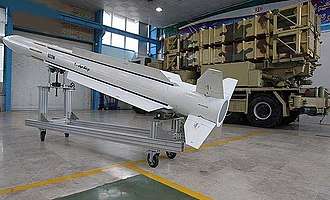Sayyad-2
Sayyad 2 (Persian: صیاد-۲, Hunter II) is a mid-range, high altitude solid fuel surface-to-air missile (SAM)[2] manufactured by Iran.
| Sayyad-2 (Hunter II) | |
|---|---|
 A Sayyad-2 system of the Islamic Republic of Iran Air Defense Force in 2015. | |
| Type | Mobile long range surface-to-air missile with anti-ballistic missile capability |
| Place of origin | Iran |
| Service history | |
| In service | 2015–present |
| Used by | See iran |
| Production history | |
| Designed | 2011 or earlier[1] |
| Specifications | |
| Warhead | Frag-HE |
| Propellant | Solid fuel |
Operational range | Sayyad-2: 40–45 km Sayyad-2C: up to 75km Sayyad-3: 120-150 km Sayyad-4: 210 km |
| Flight altitude | Sayyad-2: up to 27 km Sayyad-2C: up to 30 km Sayyad-3: 27-30 km Sayyad-4: 30-40 km |
| Maximum speed | Sayyad-2: Mach 3.6-4 Sayyad-2C: Mach 4.5+ Sayyad-3: Mach 4.5-5.1 |
Description
The Sayyad-2 is a canister-launched, reverse engineered version of the RIM-66 Standard Missile (SM-1) naval surface-to-air missile that Iran obtained from the United States before the 1979 revolution.[3]
It is an upgraded version of the Sayyad-1 system with higher precision, range and defensive power. Sayyad-1 is the Iranian upgraded version of the HQ-2 SAM system, however, it differs from the Chinese versions in guidance and control subsystems. Sayyad-1 is equipped with an about 200-kilogram warhead and has a speed of about 1,200 meters per second. The range of the Sayyad-2 missile is not known. Different sources claim various numbers, from 60 km to 120 km.[4]
After the unveiling ceremony in November 2013, it became clear that the Sayyad-2 missile looks similar to the SM-2 Standard SAM missile but its control fins are similar to the Iranian medium-range TAER-2 SAM missile.[5] it also announced that it will have cooperation with S-200 system via TALASH-2 interface system. It is planned that Sayyad-2 missile is added to Iranian Moudge-class frigates.[6] Iranian defense minister announced that Sayyad-2 covers the medium range and high altitudes and it has a combined guidance system.[7]
The launcher of Sayyad-2 missile that consists of 4 canisters in 2*2 configuration is one of the interesting things about this new Iranian surface to air missile because it has so much apparent similarity to American MIM-104 Patriot SAM system launchers.[8] Iran says the missile has been mounted on and successfully test-fired from the S-200 air-defense system.[9]
Sayyad-3
Sayyad-3 is a similar missile, but with a long-range capability. It has a similar diameter as Sayyad-2 but a longer body with different wings and control surfaces. Based on current estimates Sayyad-3 has a range of about 150–200 km.[10] Iranian Defence Minister Hossein Dehghan stated the maximum range is about 120 km.[11] This missile will be added to S-200 SAM systems via the TALASH-3 system.[12] Sayyad-3 on Khordad 15 (air defense system) is capable of detecting, intercepting, and destroying six targets simultaneously. The system is capable of detecting fighter aircraft, cruise missiles and unmanned combat aerial vehicles (UCAV) from 150 kilometres (93 mi) away and is able to track them within a range of 120 kilometres (75 mi) and the Sayyad-3 missile, used by the SAM system, has a range of 200 kilometres (120 mi).The system can also detect stealth targets from a distance of 85 kilometres (53 mi) and can intercept and destroy them within a range of 45 kilometres (28 mi)[13][14]
It appears that two new above missiles will be used in a similar manner to the Iranian long-range SAM system Bavar-373, to cover various ranges and altitudes.[10] The missile can also be fired by the Talaash Air Defense System.[15]
Further developments
The Iranian Navy is said to be considering some changes for the missile to be mounted on future versions of the Moudge class frigate.[16]
See also
References
- Binnie, Jeremy (12 November 2013). "Iran rolls out another medium-range SAM". Jane's 360. Retrieved 28 November 2019.
- "Iran inaugurates production line of Sayyad-2 missile", PressTV, 9 November 2013
- "Iran tests Talash air defence system - Jane's 360". www.janes.com.
- "Iran tests anti-aircraft missile system". PressTV. 16 April 2011. Retrieved 21 January 2012.
- "Sayad 2" completed the chain of Iranian hunters mashreghnews.ir
- "تجهیز ناوشکن دماوند به رادار سهبُعدی و سامانه موشکی صیاد ۲ + عکس". 19 July 2014.
- "افتتاح خط تولید موشک "صیاد 2"+عکس". 9 November 2013.
- Sayyad-2 Iranian hunter mashreghnews.ir
- "Iran launches mass production of new surface-to-air missiles", RT, 9 November 2013
- Familiarity with the 3 defense systems that Iran unveiled instead of the S300 mashreghnews.ir
- Iran announces Sayyad-3 Sam production janes.com
- "تجهیز سامانه اس200 به موشک صیاد3". 26 April 2014.
- Iran unveils new indigenous air defense system presstv.com
- Iran claims to have new air defense system jpost.com
- "Iranian Army deploys new Talash 3 Air Defence System to western Iran". Army Recognition. 28 September 2017. Retrieved 27 July 2018.
- "Commander: Iran Mulling Change in Sayyad Missiles to Mount It on Mowj-Class Vessels", FarsNews Agency, 27 January 2014